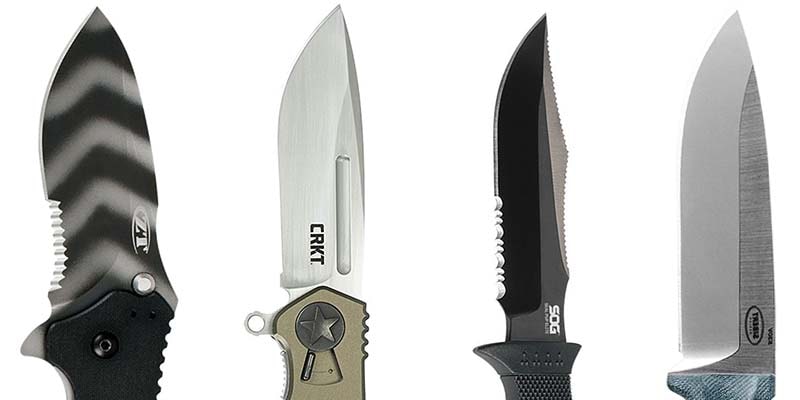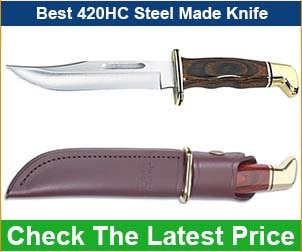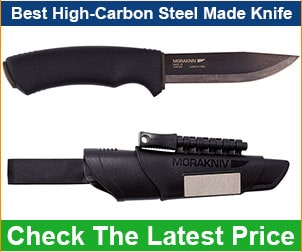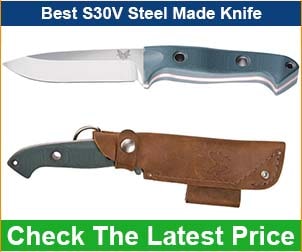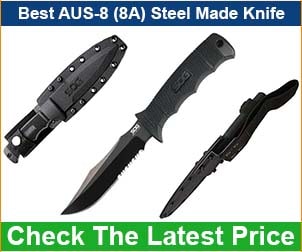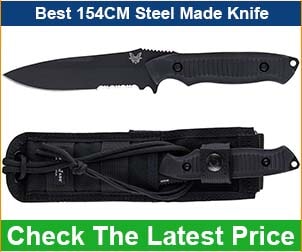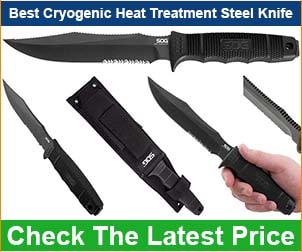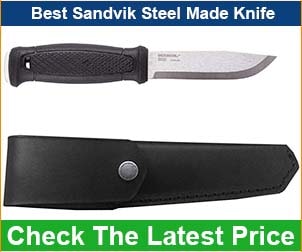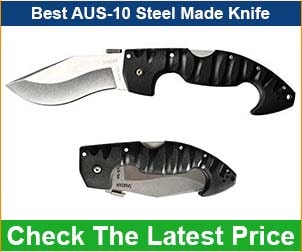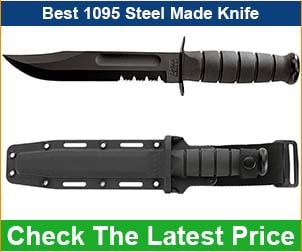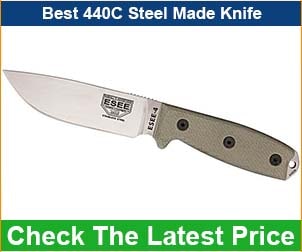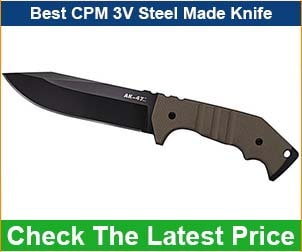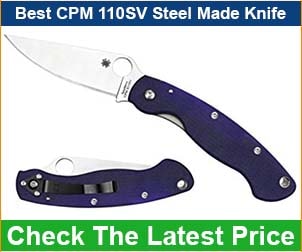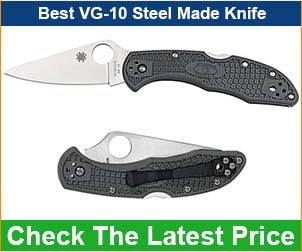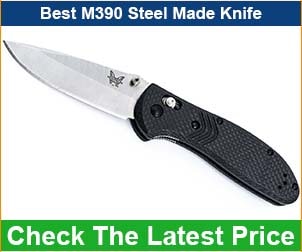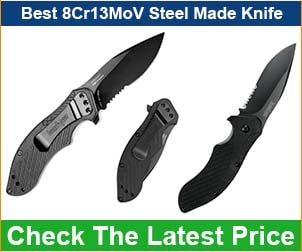Due to the sheer amount of knives in the world today, there are countless different kinds of knife steel.
All of these steels have their strengths and weaknesses, for example, some may be more susceptible to rust than others, while others may be stronger than a particular type of steel.
Others may dull much faster than other types of steel, and others still yet may lose their edge much faster than other types of steel.
Choosing the right steel for a particular type of knife can be a difficult task for beginners due to its versatile nature. And I am writing this article to make this difficult task very easy.
What Makes A Steel the Best Knife Steel?
Since there are a variety of different steels with massive differences between one particular type of knife steel and another, there are six major categories, or key properties, that any individual planning on purchasing a high quality fixed blade knife or pocket knife or kitchen knife must keep in mind before they make the purchase. These categories are hardness, toughness, wear resistance, corrosion resistance, edge retention, and ductility.
1. Hardness
Hardness is vitally important to ensure that the knife remains strong whenever stresses and pressure are applied to the blade by some sort of external object, whether it be a stick or an animal. Hardness is measured in blade steels through a scale called the Rockwell C scale. Typically, high-quality knives will have a Rockwell C score higher than 55, with the highest quality knives having Rockwell C scores around 65.
2. Toughness
Toughness is also crucial to ensure that potential damage may not occur to the blade itself. Unfortunately, a tougher blade means that the blade is not as hard, as a harder blade would be easier to crack or chip at a given time. Practical applications of a tougher knife would be for chopping thicker pieces of wood, as cutting a thicker piece of wood requires a knife that is more resistant to chipping.
3. Wear resistance
Wear resistance is yet another important quality to consider before purchasing a knife. Wear resistance is where the knife’s steel can take damage from contact with softer and harder surfaces, as well as if an object is stuck to the knife itself. This roughly correlates to hardness, as a harder knife typically means a more precise cut through an object. Therefore, a blade with a high Rockwell C rating is more wear-resistant than a blade without a high Rockwell C rating.
4. Corrosion Resistance
Corrosion resistance is perhaps one of the most important qualities that a knife could have in regions of high humidity and around saltwater. Corrosion resistance is the knife’s ability to resist severe oxidization. This does not apply to just saltwater, however, as many acidic substances can cause discoloration and rust. Generally, blades with higher corrosive resistance are harder, simply because the steel is more resistant to the oxidization process. Also, chemical differences in knives can allow for the knife to effectively resist corrosion, especially knives with higher amounts of carbides, which functions as the primary resistance against wear and corrosive elements that may affect the knife’s performance.
5. Edge Retention
Blade edge retention is another quality that can determine how long the knife can be effective as a tool. This is very important when cutting objects, as this determines how long your blade will remain sharp before dulling to the point where it becomes ineffective. Edge resistant blades typically have high wear resistance, as their edge must resist dulling effectively throughout the knife’s use. This means that knives with higher Rockwell C ratings typically perform better at maintaining their edges than knives with lower Rockwell C ratings, as knives with higher levels of wear resistance are stronger knives. Therefore, blades that are stronger have better edge retention.
6. Ductility
Finally, ductility is important to ensure that the steel does not fracture in the knife. This is important as obviously, an individual would not want to have their knife instantly shatter because the steel was not ductile. It is a common misconception that ductility correlates with high toughness, as knives used for the preparation of animals such as fillet knives need to have high ductility to cut through useless parts of a carcass that will not be cooked.
Throughout history, the practice of making blades has evolved to make the blades more durable. One of the most durable types of blades created was the Damascus steel blades. Damascus steel was for many centuries predominantly in the Middle East and Near East. Damascus steel is most notable for the fact that people have lost the ability to forge it, therefore it is highly valuable.
Due to the fact that the method in which to forge these blades have been lost to time, many legends regarding the blade’s strength have been propagated throughout popular culture. It is most known for swirling patterns in the blade caused by two different sheets of steel being merged together to form the blade. Some knives such as the Damascus Bowie Knife, Damascus Gyuto Knife, Damascus Sushi Knife are in great demand at the present time.
One of the main reasons that knives are damaged or destroyed earlier than people are reckless with their knives, especially their knife steel. Obviously, one should sharpen their knife’s blade often enough to ensure that the knife remains sharp any time it is needed.
Also, ensure that your knife blade is washed and dried regularly, because if you do not, there is a possibility that the blade my exposed to a substance such as saltwater that may oxidize the blade, leading to rust forming on the blade. When cleaning the blade, ensure that the blade is not completely submerged by liquid cleaners, as that makes it a slightly more tedious process to dry the blade. Oiling the blade every so often is also an effective measure to combat residues that remain on the blade even after washing and drying it.
Finally, ensure that the knife is set aside in a dry place when not in use so that the knife can have a longer service life. If the knife was set aside in a wet area, the chances of the blade oxidizing and rusting would drastically increase, to the point that it would be almost futile to wash and clean your blade after every time you use it.
My Recommended 15 Best Knife Steels in the World
Now, after all this discussion on different qualities of steel and how to take care of your blades, let’s go over some of the predominant high-quality steels being produced on the market today, and review them to see which ones are not necessarily the best, but the most ductile, the toughest, and hardest knives, so that people may know which knife is best suited toward a particular task.
1. 420HC Steel
First up is the 420HC Steel by Latrobe Specialty Metals. The 420HC is a steel that has a higher carbon amount than the last-generation 420. It is considered budget steel, used for cheaper blades and especially traditional bowie knives and multi-tools. This blade, while considered on the lower end of blade quality, manages to be one of the most corrosive-resistant blades out there in the market. It is also incredibly easy to sharpen, however, it has poor edge retention, and therefore you are going to need to sharpen the 420HC often in order to ensure that your blade is effective. 420HC Steel is used to make some of the best buck skinning knives.
2. High-Carbon Steel
High-carbon steels, in general, are non-stainless steels with incredibly high carbon amounts. This means that high-carbon steels are incredibly hard with decent edge retention, however, be warned by the fact that high-carbon steels are very susceptible to oxidizing, which means that you need to maintain your blade in order to prevent rust and discoloration to occur on your blade. High-carbon steel is often used on newer models of pocket knives and multi-tools. Also, the material has been used by master artisans to make top-quality Japanise chef’s knives like Sushi Knife, Deba Knife, Guyto Knife, Nakiri Knife, Santoku Knife as well as many other kitchen knives too. High-carbon steels also are prone to cracks and chips forming in the blade, making them ineffective for long-term usage, so be careful not to damage high-carbon steels.
3. S30V Steel
Next up is the S30V steel manufactured by Crucible Industries. This steel is on the very high end of the price scale and is used primarily for expensive folding knives under $200 and premium quality fixed blade knives. It is moderately difficult to sharpen, however, it has excellent hardness, as well as good edge resistance and good corrosion resistance due to the steel containing a high amount of vanadium. However, do be concerned about wear resistance, as it is easy enough to chip, especially in the harder variants of the steel. Check out some of the best S30V knives which are made by Spyderco, Zero Tolerance, Kershaw, Gerber, and Buck Knives brands.
4. AUS-8 (8A) Steel
Next up for review is the AUS-8 (8A) steel produced by Aichi Steel. AUS-8 steel is a very tough stainless steel, however not incredibly hard as a result. This means that corrosion is a serious concern for this blade as well as terrible edge resistance. AUS-8 steel is fairly low-budget steel that is quite easy to sharpen. This type of steel, therefore, is very common in new SOG knives and worldwide due to its lower price amongst the stainless steel as well as its ease to sharpen. Overall, it is decent steel with problems regarding corrosion.
5. 154CM Steel
Following that is the 154CM steel by Crucible Industries. This steel is higher-end steel with good edge retention as well as decent corrosive resistance thanks to the steel being partially infused with molybdenum. It is also moderately easy to sharpen. 154CM steel is predominantly used by high-quality pocket knives and any bladed tool that is capable of cutting for long periods of time due to its edge retention. It is typically at a Rockwell C level between 59-61, which means it is moderately hard in comparison to other blade steels.
6. Cryogenic Heat Treatment Steel
An interesting development in knife steel has been the introduction of cryogenic heat treatment steel into the market. Cryogenic heat treatment is where the blade’s temperature is decreased to approximately -300 degrees Fahrenheit and then returned slowly to room temperature. The supposed benefit of this is that toughness will be approved due to slight molecular changes in the blade, as well as wear resistance and edge resistance. This means that the life expectancy of the blade increases dramatically. Currently, this has been used by SOG to sell their specialty tactical knives. It is also one of the best steel for serrated knives. Judging from customer appreciation of the blade itself, it seems very reasonable that the knife market will be seeing more blades that are cryogenically treated.
7. Sandvik – 13C26 Steel
The next blade steel to be discussed will be the 13C26 steel made by Sandvik. This steel is most known for how easy it is to sharpen provided that you have a high-quality sharpener, though that comes with the downsides of it having mediocre edge resistance and corrosion resistance. This means that it is slightly above average in terms of hardness, with a Rockwell C rating of around 58-60. Interestingly enough, the previous generation of 13C26 steel was originally developed for razor blades.
8. AUS-10 Steel
Another high-quality blade steel is the AUS-10 steel produced by Aichi. This is a higher-quality version of the AUS-8, with significantly more carbon in the molecular portions of the blade. This is a very popular blade due to the AUS-10 being somewhat tougher than its competitors. As AUS-10 is expensive steel, therefore some well-known knife brands like SOG, CRKT, and Cool Steel use this steel for their best EDC tactical knives as well as high-quality tactical fixed blade knives. However, AUS-10 does suffer from being easily susceptible to oxidization, therefore this steel requires a decent amount of maintenance. The reason why AUS-10 is so prone to rust is that it has a higher amount of vanadium in it than other steels, and while vanadium is the main reason AUS as a brand is tougher on average, it is also the reason why corrosion on the blade occurs.
9. 1095 Cro-Van Steel
One of the most common steels on the Ka-Bar US Marine Corps Knives and the market is the 1095 Cro-Van steel, which is produced by a variety of fixed blade knife companies. 1095 Cro-Van steel is so widespread on the market simply because it has been on the market for a very long period of time and is very inexpensive, so it is used on all types of pocket knives and fixed blades, especially fighting knives. This steel is also one of the toughest steels on the market, making it effective for any short-term task. It is also very easy to sharpen, though it does suffer from mediocre edge resistance and terrible corrosion resistance.
10. 440C Steel
Another common steel is 440C steel. Several decades ago, the 440C steel was considered one of the more high-end steels, however, now it is considered average. This steel is moderately tough and is not that effective against corrosion resistance. However, it is relatively easy to sharpen, though to be fair it is average on-edge resistance. Overall, this knife is incredibly average in comparison to other knife steels, but this makes it useful for the market, as it is cheap enough for the best folding knives under $50.
11. CPM 3V Steel
Yet another common steel is the CPM 3V manufactured by Crucible Industries. The CPM 3V is known for its incredible toughness, as is common with steels forged by Crucible Industries. This blade also has incredibly high edge resistance, meaning that it is suited to long periods of use without dulling or chipping the blade. The downside to CPM 3V steel is that it is harder to sharpen than many of the more common blades on the market. The CPM 3V steel is also incredibly prone to corroding, and therefore users should wash, oil, and dry their blades regularly. Check out some of the best folding knives under $300 that have different series of CPM stainless steel blades.
12. CPM 110SV Steel
Crucible Industries also has manufactured even more fantastic steel in the form of the CPM 110SV steel. The CPM 110SV is an incredibly high-cost blade that is used on expensive tactical knives. It is an incredibly tough blade but is most widely known for how vastly superior the edge resistance on this steel is compared to other steels in the market. It also manages to have fantastic wear resistance due to its high amounts of vanadium compared to every other steel in the market. However, trying to sharpen CPM 110SV is almost impossible to accomplish due to its toughness.
13. VG-10 Steel
Another high-end steel is the VG-10 produced by Taekfu. The VG-10 is most notable for its high corrosion resistance due to its higher chromium concentration in the steel. There is also a higher vanadium concentration in the steel, meaning that VG-10 is slightly tougher than average steel. The downsides to this are that the blade is only mediocrely hard and it dulls often, though this is mitigated by the fact that the VG-10 steel is very easy to sharpen. VG-10 is a reasonably priced steel for its quality and is commonly used in the best EDC knives under $100.
14. M390 Steel
The M390 steel forged by Bohler is incredibly high-end steel that is known for its high edge retention. M390 steel is extremely hard and was specifically designed to be as corrosive-resistant as possible. Downsides are the fact that the blade is not particularly hard, with a Rockwell C rating around 60, as well as the fact that it is incredibly challenging to sharpen properly, just like all super steels. A variety of metals such as tungsten and molybdenum were infused into the steel to ensure maximum quality.
15. 8Cr13MoV Steel
On the other side of the economic spectrum is the 8Cr13MoV steel knife. This knife is very low-budget steel that is used commonly in low-quality folding knives under $30. It is slightly above average in terms of hardness than the majority of knives on the market and is particularly easy to sharpen. However, the 8Cr13MoV suffers from having low corrosion resistance and suffers from terrible edge retention, meaning that a lot of maintenance is required for the knife to last a long period of time.
Final Verdict
Overall, if I had to choose which one of these knife steels were in my opinion, I would choose the good old 420HC steel. One reason for this is that the 420HC is reasonably priced since it is a generically produced steel, and therefore is common in the market. Furthermore, I live in an area where I am exposed to saltwater and humidity often, and the 420HC was specifically designed to ensure that corrosion resistance was minimized. The only downside to that knife would be that the 420HC has mediocre edge retention, but that is no issue when you have a decent quality knife sharpening system, and the 420HC is easy to sharpen.
